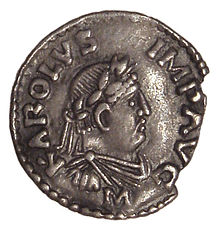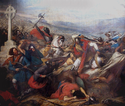- Carolingian Empire
-
Carolingian Empire (800–888) is a historiographical term which has been used to refer to the realm of the Franks under the Carolingian dynasty in the Early Middle Ages. This dynasty is seen as the founders of France and Germany, and its beginning date is based on the crowning of Charlemagne, or Charles the Great, and ends with the death of Charles the Fat. Depending on one's perspective, this Empire can be seen as the later history of the Frankish Realm or the early history of France and of the Holy Roman Empire.
The term refers to the coronation of Charlemagne by Pope Leo III in 800.[1] Because Charles and his ancestors had been rulers of the Frankish realm earlier (his grandfather Charles Martel had essentially founded the empire during his lifetime), the coronation did not actually constitute a new empire. Most historians prefer to use the term "Frankish Kingdoms" or "Frankish Realm" to refer to the area covering parts of today's Germany and France from the 5th to the 9th century.
Buildup and defense of the Frankish Realm
Though Charles Martel chose not to take the title King, as his son Pepin III the Short would, or Emperor, as his grandson Charlemagne would be titled, he was absolute ruler of virtually all of today's continental Western Europe north of the Pyrenees. Only the remaining Saxon realms, which he partly conquered, Lombardy, and the Marca Hispanica north of the Pyrenees were significant additions to the Frankish realms after his death.
Martel was also the founder of all the feudal systems that marked the Carolingian Empire, and Europe in general during the Middle Ages, though his son and grandson would gain credit for his innovations. What is more, Martel cemented his place in history with his defense of Christian Europe against a Muslim army at the Battle of Tours in 732. The Iberian Saracens had incorporated Berber lighthorse cavalry with the heavy Arab cavalry to create a formidable army that had almost never been defeated. Christian European forces, meanwhile, lacked the powerful tool of the stirrup. In this victory, Charles earned the surname Martel ("the Hammer"). Edward Gibbon, the historian of Rome and its aftermath, called Charles Martel "the paramount prince of his age."
Pepin III accepted the nomination as king by Pope Zachary in about 751. Charlemagne's rule began in 768 at Pepin's death. He proceeded to take control over the kingdom of his brother, which was also inherited from Pepin, and was crowned Roman Emperor in the year 800.[2]
The Empire during the reign of Charlemagne (768–814)
See also: Carolingian Renaissance A coin of Charlemagne with the inscription KAROLVS IMP AVG (Karolus imperator augustus)
A coin of Charlemagne with the inscription KAROLVS IMP AVG (Karolus imperator augustus)
The Carolingian Empire at the death of Charlemagne covered most of Western Europe like the Roman Empire had before. Unlike the Romans, who ventured beyond the Rhine only for vengeance after the disaster at Teutoburg Forest (9 AD), Charlemagne decisively crushed all Germanic resistance and extended his realm to the Elbe, influencing events almost to the Russian Steppes.
The Empire of the Carolingians had been divided among various members of the Carolingian dynasty. From the inception of the Empire, these included: King Charles receiving Neustria, King Louis the Pious receiving Aquitaine, and King Pepin receiving Italy. Pepin died with an illegitimate son Bernard in 810, and Charles died without heirs in 811. Although Bernard succeeded Pepin as King of Italy, Louis was made co-Emperor in 813 and the entire Empire passed to him with Charlemagne's death in the winter of 814.[3]
The Empire until the Treaty of Verdun (814–840)
 Louis the Pious on a sesquisolidus
Louis the Pious on a sesquisolidus
Louis the Pious often had to struggle to maintain control of the Empire. King Bernard of Italy died in 818 in imprisonment after rebelling a year earlier, and Italy was brought back into Imperial control. Louis' show of penance for Bernard's death in 822 greatly reduced his prestige as Emperor to the nobility. Meanwhile in 817, Louis had established three new Carolingian Kingships for his sons of his first marriage: Lothar was made King of Italy and co-Emperor, Pepin was made King of Aquitaine, and Louis the German made King of Bavaria. His attempts in 823 to bring his fourth son (from his second marriage), Charles the Bald into the will was marked by the resistance of his eldest sons, and the last years of his reign were plagued by civil war.
Lothar was stripped of his co-Emperorship in 829 and was banished to Italy, but the following year his sons attacked Louis' empire and dethroned him in favour of Lothar. The following year Louis attacked his sons' Kingdoms, stripped Lothar of his Imperial title and granted the Kingdom of Italy to Charles. Pepin and Louis the German revolted in 832, followed by Lothar in 833, and together they imprisoned Louis the Pious and Charles. In 835, peace was made between the family and Louis was restored to the Imperial throne. When Pepin died in 838, Louis crowned Charles king of Aquitaine whilst the nobility elected Pepin's son Pepin II, a conflict which was not resolved until 860 with Pepin's death. When Louis the Pious finally died in 840, Lothar claimed the entire empire irrespective of the partitions.
The dispute sparked another war, this time with Charles and Louis the German allied against Lothar. After losing the Battle of Fontenay to his younger brothers, Lothar fled to his capital at Aachen and raised a new army. The new forces were inferior to that of the younger brothers. In 842, the Oaths of Strasbourg Charles and Louis agreed to declare Lothar unfit for the imperial throne. The Oaths of Strasbourg, marked, before the Verdun Treaty the East-West division of the Empire between Louis and Charles. Considered as a milestone in the European History, the Oaths of Strasbourg is a symbol of the birth of France and Germany.[4] The empire was finally partitioned in 843 by the Treaty of Verdun.[5]










